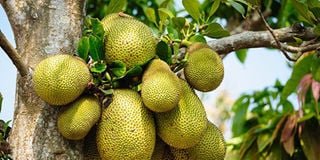Tips for planting and harvesting jackfruit

What you need to know:
- The jackfruit tree, sometimes also known as the jack tree, is a fig, mulberry, and breadfruit family tree.
- Its origins are in the region between southern India’s the Western Ghats, Sri Lanka’s entire island, and Malaysia’s rainforests.
Do you want to grow your own jackfruit tree and do you have any doubts about growing jackfruit tree? Well, and then you will need to follow this complete article to have a perfect grip on growing jackfruit trees.
The jackfruit tree, sometimes also known as the jack tree, is a fig, mulberry, and breadfruit family tree.
Its origins are in the region between southern India’s the Western Ghats, Sri Lanka’s entire island, and Malaysia’s rainforests.
About jackfruit
Growing jackfruit trees bear fruit in three to four years and can survive up to 100 years, though their yield declines with age.
Fertilise your growing jackfruit tree with an 8:4:2:1 ratio of nitrogen, phosphate, potassium, and magnesium administered to 30grammes per tree at six months of age, doubling every six months until the tree is two years old.
Growing jackfruit trees should get 35.5 ounces or one kilogramme per tree after two years in a 4:2:4:1 ratio applied before and after the wet season.
Removal of deadwood and thinning of the expanding jackfruit tree are two other aspects of jackfruit care. Pruning the jackfruit to keep it at roughly 15 feet or 4.5 meters tall will make harvesting easier.
Maintain a moist but not wet environment for the tree roots.
Soils
Jackfruit thrives on deep, sandy loam to clay loam soils with good drainage and medium fertility.
Because of the quick depletion of soil nutrients by plants, soil fertility should be taken into account. Although jackfruit can be cultivated in a range of soils, it thrives in a rich, deep, alluvial, and well-drained environment.
If sufficient nutrients are available, it can grow in open-grained or lateritic soil. It thrives in a warm, humid climate up to 1500 metres above sea level.
Propagation
It is not difficult to propagate jackfruit seeds, but you must obtain seeds that are quite fresh. They can lose viability as soon as a month after the fruit is harvested, while some can last up to three months. Soak your seeds overnight in water before planting them in the soil. When the rootstock is less than a year old, it should be grafted. They should be healthy and not root bound, as this can weaken the jackfruit tree over time, resulting in poor growth and fruiting, as well as disease susceptibility.
Planting
The jackfruit tree can be simply planted in containers, but big containers are recommended for root development. Keep in mind that the drainage in these containers must be adequate. It works nicely in containers with a 20-inch diameter and a 24-inch depth. Plant the seeds right away.
Maintain a consistent moisture level in the soil while avoiding overwatering. Feel the dirt with your finger up to the first knuckle to see if it is damp. If it is not, give the seeds some water.
Even though jackfruit thrives in humid, tropical climates with plenty of rain, too much water can cause the seeds and roots to rot.
Young jackfruit trees require daily watering to establish their roots. To water the tree at its base, use a garden hose or a watering pail. Make sure the soil is wet 1.5 inches or 3.8cm deep, but not more, to avoid overwatering.
Spacing
The planting distance is 10 metres x 10 metres and 12 metres by 12 metres in dry and humid areas. Therefore, in the model scheme, a spacing of eight metres by eight metres per acre is considered with a population of 63 plants which was found to be expected in the covered areas during the field study.
Fertilising
Fertilise your growing jackfruit tree with an 8:4:2:1 ratio of nitrogen, phosphate, potassium, and magnesium administered to one ounce or 30 g per tree at six months of age, doubling every six months until the tree is two years old. Growing jackfruit trees should yield 35.5 ounces after two years (one kilogramme)
Best practice
Pruning the tree will allow for better ventilation and a reduction in relative humidity in the canopy. Remove sick fruit from trees and the ground and destroy it. Remove decaying organic debris from the tree and the area around it. Make sure there is no water ponding around the tree’s root zone.
Maturity
90 to 110 days after the emergence of the spike has been identified as the optimal harvest maturity stage for jackfruit. The spines on the fruit’s exterior flatten as it ripens to full maturity. Harvesting is done by chopping off the fruit-bearing footstalks.
Even though trees take a long time to develop, jackfruit trees grow quickly. You should expect your jackfruit tree to yield harvestable fruits three to four years after planting. Allow jackfruit to mature on the counter. When the fruit is fully ripe, it should yield slightly when pressed.
Refrigerate for up to seven days or freeze for up to two months after wrapping sliced fruit tightly in plastic wrap or an airtight container.
Pest and disease control
In production and management, we must prevent and control several diseases such as anthracnose, powdery mildew, gummosis, and other diseases, and kill armyworm, leafhoppers, and longhorn beetle ensure the average growth of jackfruit. It is also essential to take care of pests and diseases in the care of jackfruit trees.
Deal with them as they do with organic pesticides, cultural and biological controls, or horticultural oils. A wide range of pests, insects, and diseases affect the jackfruit tree. Because this fruit tree is susceptible to many diseases, many varieties have been developed that are resistant to disease, dwarf, durable, and highly productive.
Most of these pests and diseases can be controlled by pest management and the proper use of fungicides, bactericides, and germicides. Most diseases start at the top of the canopy and spread down to other tree parts. Therefore, it is important to prune the upper foliage and remove diseased leaves and branches.
SOILS
Alluvial soils with a deep and open texture are ideal for growing Jackfruit. However, because of the greater range of conditions it may be grown in, it can be cultivated in a variety of soils as long as they are well-drained.
PRUNING
Pruning should maintain a good balance between growth and fruit. The goal of the jackfruit grower is to cultivate the most marketable fruit at the lowest cost, which can be achieved through selective harvesting. Thinning out the crowded plants and lighting the middle of the tree will permit air for ventilation, sun for colouring the fruit, and ready access for spraying.




